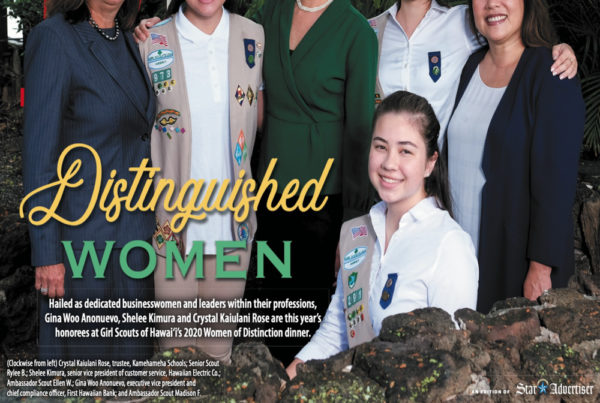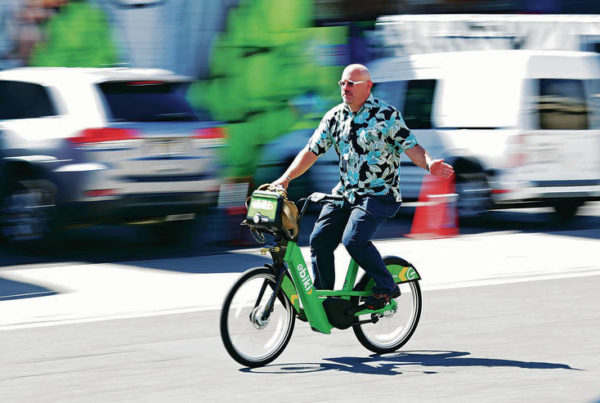Midweek
June 26, 2018
 Biki’s bright blue bicycles have become commonplace in neighborhoods from Chinatown to Diamond Head, with everyone from families to tourists to business people taking advantage of this new mode of transportation. It has become so established as a means of travel that it’s difficult to believe Biki has been around for only a year — it celebrates its anniversary June 28.
Biki’s bright blue bicycles have become commonplace in neighborhoods from Chinatown to Diamond Head, with everyone from families to tourists to business people taking advantage of this new mode of transportation. It has become so established as a means of travel that it’s difficult to believe Biki has been around for only a year — it celebrates its anniversary June 28.
Seeing the number of people using Honolulu’s bikeshare system is success enough, to hear Lori McCarney tell it. (So far, Biki has logged more than 800,000 rides.) As CEO of Bikeshare Hawai‘i, Biki’s managing arm, she has familiarized herself with other systems around the world and affirms that Honolulu’s network is top-notch. Statistics further solidify Biki’s first year as monumentally prosperous.
Bikeshare systems in the U.S. average 1.7 rides per bike per day — a pretty impressive number considering America’s dominant car industry. According to Biki’s May statistics, though, it averages 2.9 rides per bike per day.
“I think as far as our first year goes, if you measure by ridership, then it’s extremely positive,” McCarney adds.
Biki entered the local transportation scene with 100 stations and 1,000 bikes, and during its first year in business there have been numerous requests for more. This summer, the public can expect 30-40 new stations in the Iwilei, Makiki, Diamond Head and Mānoa areas, thanks to federal TAP funds. This will grow Biki’s reach to more residential areas and pedestrian-heavy places, including Honolulu and Kapi‘olani community colleges, and University of Hawai‘i at Mānoa.
“This expansion is really looking to serve some of those people that have been at the table for a while, but because of the density required, wasn’t a fit for the first launch,” explains grants and programs manager Justine Espiritu.
All new stations will be strategically placed near feeder pathways,which fits well with the city’s push for complete streets.
“The timing has really aligned with the infrastructure that’s being put in, as well as this whole network that already exists,” she adds.
Espiritu notes that upward of 90 spots were selected as potential new sites for this first expansion and more stations can be installed on an annual basis through 2020. She encourages riders to submit a request for Biki stops online at gobiki.org/ request-a-station.
The bikeshare industry as a whole is relatively young. Vélib’, the first bikeshare system of this generation, launched in Paris in 2007, and New York City’s Citi Bike only recently celebrated its five-year anniversary.
It was no surprise, then, for utter confusion to break out when Bikeshare Hawai‘i started Biki installations early last year.
“I think people didn’t know what we were doing,” McCarney says. “It was blue bikes everywhere, but the community was patient with us and embraced it. I was really pleased to see the reaction we got from people in Honolulu.”
A big draw is the bike model itself, which McCarney says is top-of-the-line from manufacturer PBSC Urban Solutions. It’s lightweight and easy to maneuver, making it a viable option for a wide range of riders. Also a plus are the various riding plans. There’s everything from a single-ride fare to monthly bundles and the Free Spirit Plan, the latter of which is McCarney’s brainchild.
“I tried to look at how people will ride,” she explains. “Some will ride consistently, some will ride every once in a while, and some will ride just one time. The Free Spirit Plan just takes off a bank of time (300 minutes), so people can have an enjoyable experience.”
For those that haven’t ridden a bicycle in decades, the old adage “just like riding a bike” proves true. To alleviate the unease, Bikeshare Hawai‘i and Biki have partnered with Hawai‘i Bicycling League to offer free classes each month. Participants will learn about the Biki system, different cyclist laws and regulations, and various routes, and will end the lesson with a guided ride. And if you run into trouble while Biki-ing, there’s a call center available from 6 a.m. to 11 p.m. every day of the year.
Biki prides itself on appealing to a variety of riders. It’s for the tourist who wants to visit Kaka‘ako to see the wall art or the CEO who needs to get to a business meeting across town. Women can hop on in a dress and heels — McCarney personally attests to this — or people can jump on for a quick ride as part of their exercise routine.
It seems there’s no limit to Biki and its usefulness. In fact, McCarney ran into two athletes at the Lanikai Triathlon in April who used Bikis for the cycling leg of the race.
“What you obviously see are the bikes and the stations, but this is really a people business,” she adds. “There are a lot of people involved, and we really believe in being there for people and making sure they have a good experience.”
Biki is led by the Bikeshare Hawai‘i team — a trio consisting of McCarney, Espiritu, and marketing and communications manager Kelsey Colpitts — and operator Secure Bike Share, in partnership with the city and state. In line with its people-centered mentality, efforts are in the works to utilize Biki more as a community-engagement tool. Espiritu, for example, is working with Waikīkī Health to offer free Biki access to its patients, while Colpitts partners with local small businesses through Biki Bites (food/ restaurant) and Biki Buys (retail/shopping).
“There are so many businesses I’ve discovered just by being on a Biki that I wouldn’t have driving in a car,” Colpitts says.
Honolulu’s bikeshare system was introduced as a way to address some of the city’s ongoing issues — from well-being to infrastructure — and over the months has grown its mission to be a champion of the local community. Overall, McCarney is glad that interest and need are increasing. It shows that Biki is doing its job for the community and the city.
“We’ve done a number of things that made it easy for people just to try it,” Espiritu adds.
“Bikeshare doesn’t solve anything 100 percent, but it has an impact on a lot of different things,” McCarney adds.
It addresses the state’s green-energy goals and focus on health, as well as helps out with traffic congestion and air pollution — not to mention it’s cost-effective.
“We don’t have room to put bigger roads or more parking lots,” McCarney adds. “We want to provide different ways for people to do things that are going to be healthier, and greener and more fun. Our goal is for people to see biking as an option.”
For fare information and updates on Biki Bites and Biki Buys, visit gobiki.org or download the app (free for iOS and Android).
 CHAT WITH A BIKI BELIEVER
CHAT WITH A BIKI BELIEVER
Bob Greenberg (pictured below) is no stranger to bikeshare systems, having utilized them in New York and Israel, and was ecstatic when Biki was introduced to Honolulu last year. He became a member about two weeks after the launch and hasn’t looked back since. “I greatly cut down on using the car,” he says. “It’s more convenient to go places, and it’s faster and easier to park by just jumping on the Biki.”
In the past year, he’s driven his car about 800 miles, shaving 2,000 miles off his driving average. In fact, he and his wife have a new saying: “If we can’t get there by Biki, it ain’t worth going.”
While Biki has been an extremely positive experience for Greenberg, he is an advocate for bettering the bikeshare system as a whole, citing the need for more bike lanes and a Biki stop expansion. (Read the main story for more on the proposed expansion.)
Greenberg, who was named Biki’s member of the month for May, encourages people to just try Biki, especially the older crowd, who he says can utilize the system as a form of exercise.
“Just get on and try it. They’re extremely comfortable, especially for old fat guys like me,” he adds, with a laugh.
Greenberg’s suggestion for older riders hasn’t gone unnoticed. Nonprofit Bikeshare Hawai‘i — Biki’s managing arm — recently applied for an AARP grant that covers aging in place. According to Bikeshare Hawai‘i CEO Lori McCarney, it’s a step in the right direction.
“We want to be able to introduce Biki and bikeshare to younger seniors,” she says. “If we can introduce it to them in their early 50s or 60s, and they start to use that as a mode of transportation, then that can carry on into their later years and give them more mobility and socialization over time.”






